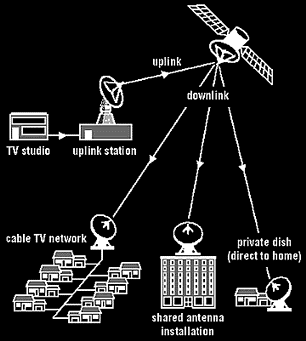
Week 9: Media coverage Satellite and its user cable TV
Media Coverage Satellite and its User Cable TV
Understanding the difference between Cable TV, Satellite TV, IPTV, and OTT (over-the-top) streaming services can be tricky — particularly as content providers scramble to offer bundled services that blur the line between Internet and broadcast media.
While cable subscription numbers have been tailing off in favor of alternatives like Netflix and Hulu, the video-consumption industry on the whole has only grown. There are more ways to tune into our favorite shows than ever before.
More choices translate to more power for consumers, but only if you take a moment to understand the differences between the various types of TV connection available on the market today.
Our goal in this post is to walk you through the basics of each “flavor” of television, explaining both how they work and how to decide which is best for you and your household.
In the first section we’ll cover the basics everyone should know. In the second, we’ll dive into more detailed descriptions of how each network operates.
First, some quick definitions:
THE FOUR FLAVORS OF TELEVISION
- Satellite TV: Television from providers like DirecTV, delivered via radio waves.
- Cable TV: Television from providers like Time Warner Cable, delivered via coaxial cable connection.
- IPTV (Internet Protocol Television): Television from providers like Prism TV, delivered over the Internet via a privately-managed network.
- OTT Streaming: Television from third-party services like Netflix and YouTube, delivered over the open Internet
There are essentially two ways to get television content in your home: you can tune in to broadcast networks, or you can request streamed content via Internet networks.
Broadcast networks include:
- Satellite TV
- Cable TV
As the name suggests, broadcast networks operate by broadcasting content from a central point. In the case of cable, content is broadcast through a dedicated coaxial cable network. In the case of satellite, it comes as radio waves that you pick up with a satellite dish (or cable box) on top of your house.
Cable and satellite both function by letting you “tune in” to specific channels within that signal. The primary difference is that cable comes through a wired connection while satellite is wireless (until it reaches your house, anyway).
Internet networks include:
- IPTV
- OTT Streaming
Internet networks differ from cable and satellite by offering content through the same client-server model that delivers your email, websites, and other Internet-based services. (IP stands for Internet Protocol, the “language” used to transfer packets of data between computers attached to the Internet network.)
In both cases, the consumer requests and receives content via Internet Protocol. The primary difference between IPTV and OTT streaming is that OTT streamed content comes over the same open, unmanaged network as your email and web browsing while IPTV uses a private, dedicated network to deliver more consistent service.
Unlike cable or satellite where content is broadcast in real time, IPTV and OTT streaming services store programming on servers (whether that’s Netflix or an IPTV subscription like U-Verse), allowing users to request the content over the Internet at any time. These also frequently come in bundle packages from internet providers like CenturyLink, Viasat, AT&T and Spectrum.
PROS AND CONS FOR CONSUMERS
For most of us, the cost and functionality of home TV is more important than understanding the nuts and bolts. With that in mind, here’s a quick overview of each option:
CABLE TV
Pros:
- Quality: Dedicated line for high-quality video with no “buffering.”
- Programming: Hundreds of channels, with programs available date of release.
- Frequently bundled with broadband cable Internet for a lower price.
Cons:
- Availability: Only available near service providers.
- Cost: Generally higher than satellite, IPTV, and OTT streaming.
- Convenience: Requires a separate device to record programming for view-on-demand.
SATELLITE TV
Pros:
- Programming: Comparable to cable, available date of release.
- Availability: Coverage virtually everywhere in the US.
- Price: Generally lower than cable, and you can pick up some channels free with a general-purpose dish.
Cons:
- Quality: Constant broadcast means no service interruption, although storms can cause outage depending on setup.
- Convenience: Requires a separate device to record programming for view-on-demand.
OTT STREAMING
Pros:
- Price: Monthly prices as lows as $5, with much free content on YouTube and Hulu.
- Installation: All you need is a laptop or phone. (Having a streaming TV box like the Roku or Apple TV enhances the experience, though.)
- Programming: Wide choice of providers, with Netflix and others now offering original programming similar to cable.
Cons:
- Quality: Subject to Internet speed, with “buffering” and other wait-times common for slow connections and peak-hour viewing.
- Programming: While most shows can be found via major streaming services, some are cable-only and they generally don’t reach OTT streaming until the end of the season.
- Data caps: Many ISPs now have limits on how much data you can consume, putting a limit on how much you can watch each month. (Yes, even with “unlimited” plans.)
IPTV
Pros:
- Quality: High-quality video with fewer interruptions than OTT streaming due to privately managed content delivery network.
- Programming: View-on-demand and get shows date of release.
- Installation: requires no special installation aside from a set-top box, assuming you already have broadband Internet.
Cons:
- Price: Sold as a subscription at comparable rates to cable TV.
- Quality: Since it comes over the Internet, it can get slowed down during peak hours.



